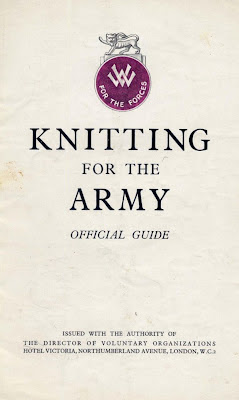The booklet was produced in preparation for the 1940-41 winter (i.e. the second winter of the war, in this country). By this time, wool was in short supply although clothes rationing was not introduced until June 1941. The booklet begins by explaining that "There is just enough wool for the knitted garments needed for the coming winter. BUT THERE IS NOT ENOUGH WOOL TO ALLOW FOR ANY WASTE WHATEVER" and says that waste of wool "was widespread in last winter's knitting efforts". Therefore knitting for the armed forces has to be carefully organized, to make sure that the garments produced are what's required, and of good quality.
The booklet specifies four acceptable garments: a cap-muffler, a sleeveless pullover, fingerless mittens extending beyond the wrist, and gum-boot stockings in oiled wool. The gum-boot stockings can be any colour, but the others should be khaki, or grey if that is unobtainable.
 |
| 1940 Garments |
The booklet shows a cap-muffler in use. "A most useful two-in-one garment. Can be used as a cap and muffler, or a muffler alone. Comfortable to wear under steel helmet. Very easily knitted." (The model looks as though he has grown a moustache to disguise the fact that he's under-age - but perhaps that's me being old.)
 |
| Cap-muffler |
The booklet finishes by describing the working of the Voluntary Knitting Industry. A complex array of orgaizations had been set up to pass wool from the Wool Controller down to local working parties, and to collect together the knitted garments and eventually issue them to the troops. There was a huge clerical effort involved in recording everything, to ensure that the working parties could get wool at wholesale prices (and presumably also to ensure that all the wool issued was returned, knitted up.) Since the Government seem to have been perfectly capable of providing soldiers with most of their kit, I do wonder how necessary it was to use volunteer knitters at all, when it required such a huge (voluntary) effort to organize it all. Maybe one advantage was just to off-load some of the cost of clothing the Army to the civilian population - though I'm sure that the knitters also benefited by feeling that they were making a contribution to the war effort.

Very interesting! I'm currently reading a book about WWI, and would like to find more info about knitting for that conflict, as well. (peppergrass)
ReplyDeleteThere is a bit of information about World War I in an earlier post of mine (in July 2011) which tells you about a pattern book from that period.
DeleteI own a few Australian-published knitting pattern books:
ReplyDeletePatons Service Woollies: Speciality Knitting Book No. 153
Sun-glo Kniing book: series 46
Patons and Baldwins No. 132 speciality Knitting Book: Men's Service and Civilian Knitwear.
I find the sock and glove patterns excellent. The balaclava with ear holes made the model look like a wing-nut, but would have meant he could hear the radio traffic.
The saddest patterns are the 'Hospital Comforts', including arm or leg amputation covers. I realised women would have been knitting these for eighteen-year-olds. Terrible.
Thanks for your comment. The Hospital Comforts patterns sound like First World War rather than Second - are they?
Delete